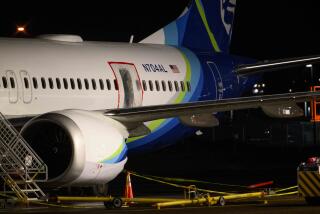Chaos described as BP hearings resume
- Share via
Reporting from Houston — The night of the massive Deepwater Horizon explosion, few in the crew knew who was in charge or understood the chain of command, and the vessel’s captain hesitated before making critical safety decisions, according to testimony Monday before a federal panel investigating the cause of the disaster that killed 11 crew members.
The lack of a clear leader contributed to the chaos aboard the ill-fated oil rig on April 20 and was the focus of intense questioning from the panel’s lead investigator.
Even a top official of Transocean, which owned the rig and leased it to BP, was unaware of the chain of command.
“Are you clear as to who was in charge?” U.S. Coast Guard Capt. Hung Nguyen asked Paul Johnson, the Transocean rig manager who supervised the Deepwater Horizon’s drilling operation from land.
“I’m not sure,” said Johnson, adding that communications were cut off during the explosion. His testimony came at the start of the fourth phase of a joint Coast Guard- Interior Department hearing investigating the cause of the explosion.
According to Transocean’s dual command structure, when the mobile rig is anchored and drilling, an on-board Transocean manager runs the operation. When the rig is on the move and during emergencies, the captain, also a Transocean employee, is in command.
Nguyen, who heads the joint panel, pressed Johnson on the importance of knowing who is in charge during an emergency.
“I never gave it much thought,” Johnson replied. “It never occurred to me to ask.”
“Do you think the transfer of command, if it was not done properly, would that be a contributing cause to the tragedy?” Nguyen asked.
“Do I think a bad handover could cause confusion? … Yes, I would,” Johnson said, acknowledging that the company did not have written policies on the issue.
Underscoring the confusion, the rig’s captain, Curt Kuchta, turned to someone else to make crucial decisions, according testimony from senior Transocean official Daun Winslow, who also said he had to prompt Kuchta to deploy lifeboats.
In the urgency of the moment, crew members were awaiting orders to disconnect the rig from the well, a key safety maneuver, said Winslow, a Transocean division manager who was on board that night. The effort to disconnect the rig from the out-of-control well failed, contributing to its eventual collapse.
Painting a scene of confusion aboard the rig, Winslow testified that Kuchta turned to him and asked if he should order an emergency disconnect from the surging well.
“I said, ‘If you haven’t disconnected by now, please do,’” Winslow said.
That prompted Nguyen to observe that Winslow’s testimony indicated that the crew, including Kuchta, seemed to be looking to Winslow for direction, even though he wasn’t in the chain of command.
Winslow said he was only making suggestions and answering questions.
One of the top BP official on board was new to the rig and his capabilities were questioned by Transocean officials, according testimony.
Four days before the explosion BP had ordered its veteran well site leader back to Louisiana for routine training and replaced him with Robert Kaluza. Kaluza played a role in overseeing a tricky procedure to seal the well, which has also come under criticism during the hearings.
“We didn’t know who this gentleman was.… I asked who was Mr. Kaluza. Where did he come from?” Johnson said. “I asked about his deep-water experience during … a critical phase of the well,” he added.
BP officials assured him that Kaluza was “an accomplished well site leader,” Johnson said.
Nguyen also disclosed a series of troubling findings from a BP audit of the rig in September:
•Not all relevant personnel on the rig were knowledgeable about drilling and well operation practices.
•A review showed significant overdue maintenance jobs that required more than 3,545 man hours.
•No single person on board the rig could account for which alarms had been disabled or for what reason.
•A warning on understaffing was issued, saying that any further reduction of experienced personnel may be “detrimental to the performance of the rig.”
Nguyen said such findings would have caused him “significant concern.”
“With all these flaws identified within this audit, do you think it is a fundamental flaw for BP to pay [Transocean] $500,000 a day knowing that there are all these problems with the rig?” investigator Jason Mathews asked Neil Cramond, BP’s top official for maritime safety in the Gulf of Mexico.
Cramond said he was comfortable with how the safety issues were addressed.
ron.lin@latimes.com
More to Read
Sign up for Essential California
The most important California stories and recommendations in your inbox every morning.
You may occasionally receive promotional content from the Los Angeles Times.














